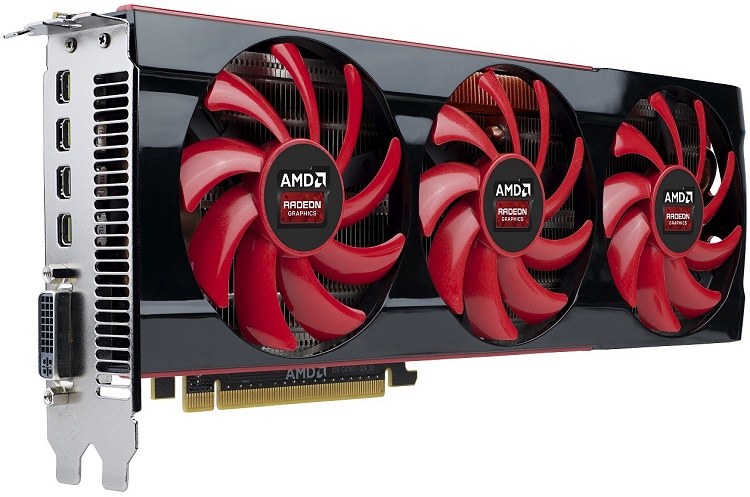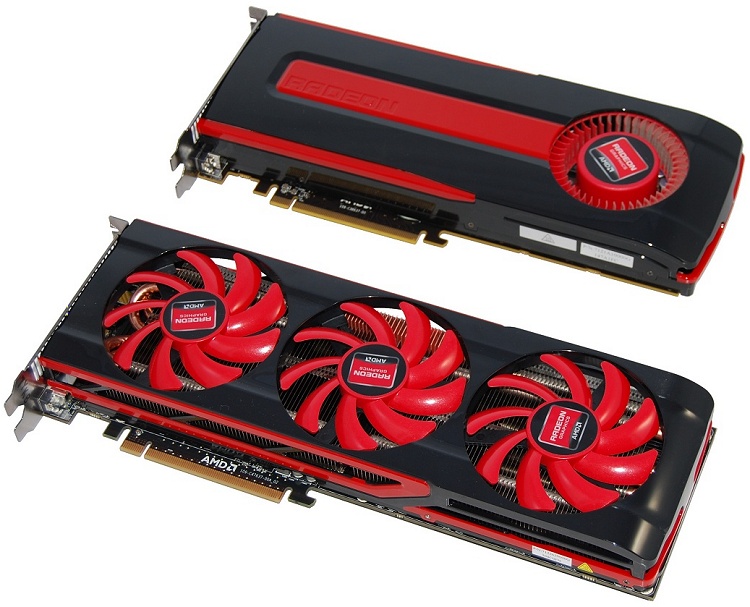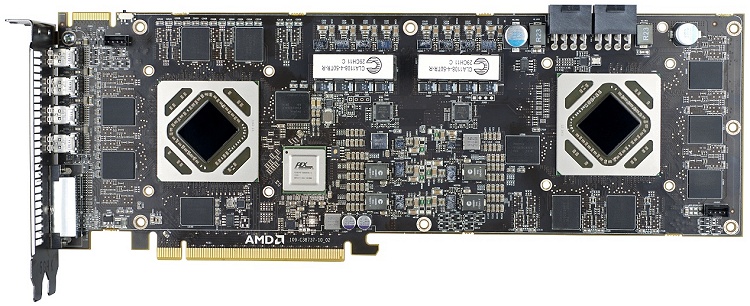AMD Radeon HD 7990 Review
The current generation AMD GPU series collectivelly known as "Southern Islands" were released over a year ago, with the beginning of its rollout in Jan 2012. Sixteen months later, the Radeon HD 7000 series is however very much relevant, as AMD continues to release new models under the same GPU family.
The Radeon HD 7790 released last month it's a product most gamers have the potential to savor considering its $150 toll tag. The Hard disk drive 7790 took the chip count for the series to x singled-out 28nm GPUs. Today AMD has a wide range of prices covered starting at $100 with the Radeon HD 7750 up to $450 with the 7970 GHz Edition.
Those able and wanting to spend in backlog of $450 on a single graphics carte need to look in Nvidia'southward direction at either the GeForce GTX 690 or the mighty GTX Titan, both extravagant $chiliad options. Alternatively, if you can support multiple graphics cards, which allow'due south exist honest well-nigh gaming systems tin, and then a pair of Radeon HD 7970 GHz Edition graphics cards should work nicely (well, kind of).

Even so AMD feels they need to offer an ultra-expensive graphics card too and therefore today they are releasing the Radeon Hard disk drive 7990. Although it's been over a year since they launched the Radeon HD 7970, nosotros are simply getting an official dual-GPU version, in truth they take been around for some time.
Products such as the PowerColor Devil 13 HD 7990 6GB, HIS Radeon HD 7970 6GB IceQ X2 and Asus ROG Ares Two take been doing the rounds for quite a while now. So while the release of an official Radeon Hd 7990 might not be radically new, it does mean a few things. For 1, pricing will be unified, as will the specifications and features. Nigh importantly availability and actual driver back up, making it much easier for cashed upward gamers to become their easily on ane.
The Radeon HD 7990 is very like to the 6990 and the 5970 before it (ohh, and the 4870 X2 before that) in the sense that it'due south basically a pair of flagship GPUs from its respective generation stuck to the same actress long PCB.
In the instance of the Radeon HD 7990 it takes a pair of 7970 GPUs with overclocked cores (from 925MHz to 1000MHz), while boosting the GDDR5 memory from 1375MHz to 1500MHz. These clock speeds happen to match the 7970 GHz Edition, though the 7990 doesn't feature a Boost clock, so nosotros feel the GPUs are better compared to the standard 7970.
Radeon Hard disk drive 7990 in Detail
Here are some figures that AMD is throwing around to describe the Radeon HD 7990: 8.6 billion transistors, 4096 stream processors, 8.2 TFLOPS reckoner power, 6GB GDDR5 and 576GB/southward memory bandwidth.
Merely, of grade, as a dual-GPU graphics card those figures are non nearly as impressive every bit they might otherwise be if nosotros were talking well-nigh a single GPU solution. 8.2 TFLOPS of reckoner ability is nothing to be sneezed at either, so nosotros will exist keen to see how the 7990 handles itself before long.
The Radeon HD 7990 is a monstrous graphics card measuring 30cm long (12 in), making it 3cm longer than the 7970 GHz Edition.

The GPU cadre is clocked at 1000MHz, 8% higher than the HD 7970, while the memory is clocked 9% higher at 1500MHz (half dozen.0GHz DDR). Pairing that frequency with a 384-bit memory bus gives the Hd 7990 a theoretical bandwidth of 288GB/s per GPU, for a whopping 576GB/s total.
Similar the Radeon Hard disk 7970 which comes loaded with a generous 3GB memory buffer, the 7990 allocates 3GB to each GPU for a total card chapters of 6GB.
We've found that when using multi-monitor setups at extreme resolutions, the larger buffer of AMD cards provide a pregnant reward over Nvidia's, which are limited to 2GB for the most office. That said, the new GeForce GTX Titan does boast a 6GB memory buffer for a single GPU.

The core configuration, or equally we should say "cores", of the Radeon Hd 7990 are the same as the single GPU 7970 versions. It carries 2048 SPUs, 128 TAUs and 32 ROPs on each GPU, and so in a sense you can double those figures.
Connecting the two graphics processors is the PEX span from PLX Technologies, which is the same method employed by all previous AMD dual-GPU graphics cards. However, the HD 7990 gets the latest iii.0 PEX8747 bridge which boasts 48 PCI Limited 3.0 lanes for 96GB/s of inter-GPU bandwidth.


Cooling the "Republic of malta" GPU are 2 massive aluminum vapor chamber heatsinks, each with 62 fins and four heatpipes. The vapor chamber design was outset implemented by the Radeon Hard disk drive 5970 and has since been adopted by numerous high-end AMD and Nvidia graphics cards. Heat is dispersed past a trio of 75x20mm axial fans that pull air in from inside the example and button it out the back.
The Hard disk 7990's fan operates quietly for the virtually part, but despite the carte du jour's impressive idle consumption of just 15 watts, information technology still chugs upwards to 375 watts nether load, and so the fan does kick up a footling during heavy gaming sessions.


The heatsink and fan are enclosed in a custom housing that conceals the entire graphics card, a mutual exercise for AMD flagship products and one nosotros tend to like. Nvidia has too done this in the past, though this is a pattern method that is typically reserved for only the about high-end products.

To feed the card enough power, AMD includes dual 8-pivot PCI Express connectors -- the same setup you'll find on the Hard disk 6990.
Naturally, the Hd 7990 supports QuadFire (Crossfire) and then there is a connector for bridging with some other carte. The only other connectors are on the I/O console. Our AMD reference sample has a dual DL-DVI connector and four mini-DisplayPort 1.two sockets which allows support for five simultaneous monitors right out of the box.
Source: https://www.techspot.com/review/663-amd-radeon-hd-7990/
Posted by: dingleaudinity.blogspot.com


0 Response to "AMD Radeon HD 7990 Review"
Post a Comment